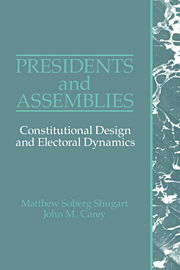Book contents
- Frontmatter
- Contents
- List of tables and figures
- Acknowledgments
- 1 Basic choices in democratic regime types
- 2 Defining regimes with elected presidents
- 3 Criticisms of presidentialism and responses
- 4 The premier-presidential and president-parliamentary experiences
- 5 The constitutional origins of chief executives
- 6 Constitutional limits on separate origin and survival
- 7 Legislative powers of presidents
- 8 Assessing the powers of the presidency
- 9 Electoral dynamics: efficiency and inefficiency
- 10 Electoral rules and the party system
- 11 Electoral cycles and the party system
- 12 Electoral cycles and compatibility between president and assembly
- 13 Conclusions
- Appendix A Electoral rules for one-seat districts and coalition-building incentives
- Appendix B Theoretical explanation for models predicting number of parties in presidential systems
- Bibliography
- Index
7 - Legislative powers of presidents
Published online by Cambridge University Press: 05 June 2012
- Frontmatter
- Contents
- List of tables and figures
- Acknowledgments
- 1 Basic choices in democratic regime types
- 2 Defining regimes with elected presidents
- 3 Criticisms of presidentialism and responses
- 4 The premier-presidential and president-parliamentary experiences
- 5 The constitutional origins of chief executives
- 6 Constitutional limits on separate origin and survival
- 7 Legislative powers of presidents
- 8 Assessing the powers of the presidency
- 9 Electoral dynamics: efficiency and inefficiency
- 10 Electoral rules and the party system
- 11 Electoral cycles and the party system
- 12 Electoral cycles and compatibility between president and assembly
- 13 Conclusions
- Appendix A Electoral rules for one-seat districts and coalition-building incentives
- Appendix B Theoretical explanation for models predicting number of parties in presidential systems
- Bibliography
- Index
Summary
INTRODUCTION
Regarding the subject of presidential power in the legislative process, we are interested in two main themes: the extent of constitutional (entrenched) presidential power, and the extent of legislative power delegated to the president by congress. These two types of legislative power are not unrelated. In particular, we argue that the presence of the former may encourage the delegation of the latter, suggesting also that students of presidential systems have regularly mistaken delegated authority for the usurpation of political power by presidents. We recognize that any delegation of authority implies the potential for agency loss but intend to demonstrate that the conditions under which delegation takes place can greatly constrain presidents from defying congressional will.
The chapter begins with a brief discussion of the distinction between entrenched and delegated legislative powers in parliamentary and presidential systems. We then proceed to examine the scope and configurations of presidential powers among systems with elected presidencies, focusing on the veto, the authority to introduce legislation, decree power, and emergency powers. It is in the areas of decree and emergency powers that the question of delegation versus entrenched authority is most pertinent. Where relevant, we include in the discussion the legislative powers of presidents in premier-presidential systems. However, most such presidents are accorded no such constitutional powers, and where delegation of legislative authority takes place in such systems, it generally involves delegation from the assembly to the premier or the cabinet.
- Type
- Chapter
- Information
- Presidents and AssembliesConstitutional Design and Electoral Dynamics, pp. 131 - 147Publisher: Cambridge University PressPrint publication year: 1992



